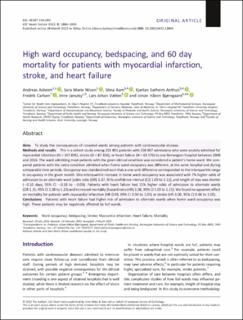| dc.contributor.author | Asheim, Andreas | |
| dc.contributor.author | Nilsen, Sara Marie | |
| dc.contributor.author | Aam, Stina | |
| dc.contributor.author | Anthun, Kjartan Sarheim | |
| dc.contributor.author | Carlsen, Fredrik | |
| dc.contributor.author | Janszky, Imre | |
| dc.contributor.author | Vatten, Lars Johan | |
| dc.contributor.author | Bjørngaard, Johan Håkon | |
| dc.date.accessioned | 2022-12-01T07:55:32Z | |
| dc.date.available | 2022-12-01T07:55:32Z | |
| dc.date.created | 2022-03-29T09:18:29Z | |
| dc.date.issued | 2022 | |
| dc.identifier.issn | 2055-5822 | |
| dc.identifier.uri | https://hdl.handle.net/11250/3035167 | |
| dc.description.abstract | Abstract Aims To study the consequences of crowded wards among patients with cardiovascular disease. Methods and results This is a cohort study among 201 801 patients with 258 807 admissions who were acutely admitted for myocardial infarction (N = 107 895), stroke (N = 87 336), or heart failure (N = 63 576) to any Norwegian hospital between 2008 and 2016. The ward admitting most patients with the given clinical condition was considered a patient's home ward. We compared patients with the same condition admitted when home ward occupancy was different, at the same hospital and during comparable time periods. Occupancy was standardized such that a one-unit difference corresponded to the interquartile range in occupancy in the given month. One interquartile increase in home ward occupancy was associated with 7% higher odds of admission to an alternate ward [odds ratio (OR) 1.07, 95% confidence interval (CI) 1.09 to 1.11], and length of stay was shorter (−0.10 days, 95% CI −0.18 to −0.09). Patients with heart failure had 15% higher odds of admission to alternate wards (OR 1.15, 95% CI 1.08 to 1.23) and increased mortality [hazard ratio (HR) 1.08, 95% CI 1.03 to 1.15]. We found no apparent effect on mortality for patients with myocardial infarction (HR 0.99, 95% CI 0.94 to 1.05) or stroke (HR 1.00, 95% CI 0.96 to 1.05). Conclusions Patients with heart failure had higher risk of admission to alternate wards when home ward occupancy was high. These patients may be negatively affected by full wards. | en_US |
| dc.description.abstract | High ward occupancy, bedspacing, and 60 day mortality for patients with myocardial infarction, stroke, and heart failure | en_US |
| dc.language.iso | eng | en_US |
| dc.publisher | Wiley | en_US |
| dc.rights | Attribution-NonCommercial-NoDerivatives 4.0 Internasjonal | * |
| dc.rights.uri | http://creativecommons.org/licenses/by-nc-nd/4.0/deed.no | * |
| dc.title | High ward occupancy, bedspacing, and 60 day mortality for patients with myocardial infarction, stroke, and heart failure | en_US |
| dc.title.alternative | High ward occupancy, bedspacing, and 60 day mortality for patients with myocardial infarction, stroke, and heart failure | en_US |
| dc.type | Journal article | en_US |
| dc.type | Peer reviewed | en_US |
| dc.description.version | publishedVersion | en_US |
| dc.source.journal | ESC Heart Failure | en_US |
| dc.identifier.doi | 10.1002/ehf2.13894 | |
| dc.identifier.cristin | 2013204 | |
| dc.relation.project | Norges forskningsråd: 256579 | en_US |
| dc.relation.project | Norges forskningsråd: 295989 | en_US |
| cristin.ispublished | true | |
| cristin.fulltext | original | |
| cristin.qualitycode | 1 | |

